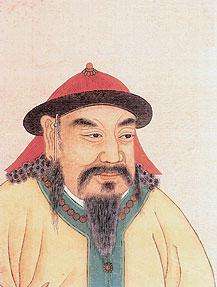Yesugei
Yesugei Baghatur or Yesükhei (Traditional Mongolian: ᠶᠢᠰᠦᠭᠡᠢ ᠪᠠᠭᠠᠲᠤᠷ; Modern Mongolian: Есүхэй баатар, Yesukhei baatar), was a major chief of the Khamag Mongol confederation and the father of Temüjin, later known as Genghis Khan. He was of Borjigin family, and his name literally means "like nine", meaning he had the auspicious qualities of the number nine, a lucky number to the Mongols.
| Yesugei Baghatur | |||||||||
|---|---|---|---|---|---|---|---|---|---|
 A 13th century portrayal of Yesugei | |||||||||
| De-facto ruler of Khamag Mongol | |||||||||
| Reign | 1160 - 1171 | ||||||||
| Predecessor | Hotula Khan | ||||||||
| Successor | Genghis Khan | ||||||||
| Born | c. 1134 | ||||||||
| Died | 1171 (aged 37) | ||||||||
| Spouse | Hoelun | ||||||||
| Issue | Genghis Khan Qasar Hachiun Temüge Belgutei Behter | ||||||||
| |||||||||
| House | Borjigin | ||||||||
| Father | Bartan Baghatur | ||||||||
| Religion | Tengrism | ||||||||
Life
Yesügei was the son of Bartan Baghatur, who was the second son of Khabul Khan. Khabul was recognized as a khagan by the Jin Dynasty. Khabul Khan was, in turn, the great grandson of the Mongol chief Khaidu, the first to try to unite all of the Mongols. Yesügei's first and chief wife, Hoelun, a daughter of the Olkhunut forest people, was abducted by Yesügei with help of his elder brother Negün Taishi and younger brother Daritai Otchigin, from her newlywed husband Chiledu of Merkits.[1] Yesügei abducted Hoelun because of her beauty and physical indications of fertility.[2]
After the Khamag Mongol confederation khan Hotula died, the confederation had no elected king, but de facto Yesügei ruled the confederation. Yesügei had a bloodbrother, or anda, Toghrul Khan (later known as Wang Khan and Ong Khan). Yesügei helped Toghrul to defeat his uncle Gurkhan. After Yesügei's death, Toghrul initially helped Temüjin in arranging his marriage to Börte and uniting the tribes, but later defected to Genghis' anda and rival, Jamukha.
In 1171 Yesügei died when his son Temüjin was nine years old. The Secret History of the Mongols records that he was poisoned by Tatars while sharing a meal at a wedding[3] on the way home after leaving his son Temüjin at home of Dai Setsen, a noble man of Khongirad tribe, when two fathers, Yesügei and Dai Setsen, agreed that their children, Temüjin and Börte, would marry in the future.[3] Yesügei died three days later at home with presence of this family and servants.
Legacy
During reign of Yuan dynasty, he was given temple name of Liezu (Chinese: 烈祖; lit.: 'Ardent Founder') and posthumous name Shenyuan Huangdi (Chinese: 神元皇帝; lit.: 'Supernaturally Prime Emperor').[4]
Family
Yesügei and Hoelun had four sons Temüjin, (later known as Genghis Khan), Hasar, Hachiun, Temüge and a daughter, Temülen. Yesugei had two sons by his second wife Sochigel: Behter and Belgutei. The Secret History of the Mongols records that in his youth Temüjin killed his brother Behter in a fight for food. His other half-brother, Belgutei, however was a good friend, and later became a general under Genghis.
See also
References
- Waley, Arthur (2013-05-13). The Secret History of the Mongols: And Other Pieces. Routledge. pp. 222–225. ISBN 978-1-136-74824-0.
- Broadbridge, Anne F. (2018-07-18). Women and the Making of the Mongol Empire. Cambridge University Press. p. 45. ISBN 978-1-108-63662-9.
- Cleaves, Francis Woodman (1982). The Secret History of the Mongols: Translation. Harvard-Yenching Institute. p. 17. ISBN 978-0-674-79670-6.
- Atwood, Christopher P. "Six Pre-Chinggisid Genealogies in the Mongol Empire". Cite journal requires
|journal=(help)